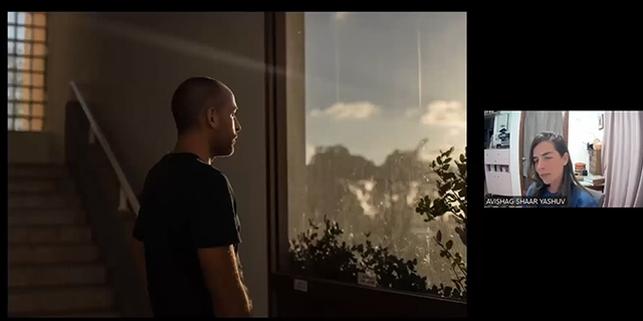
Photojournalist Avishag Shaar-Yashuv, a fellow of the Mandel Program for Leadership in Jewish Culture, discusses one of her photographs from the New York Times
Photojournalist Avishag Shaar-Yashuv, a fellow of the Mandel Program for Leadership in Jewish Culture, discusses one of her photographs from the New York Times
Exactly thirty days after the Hamas attack on Israel, the Mandel community brought together cultural leaders and thought leaders for an online discussion about the way in which the narrative of one of the most challenging moments in the history of the State of Israel is being shaped.
The meeting convened cultural leaders from various fields, who presented a broad picture of cultural work and memory. Israeli photojournalist
Avishag Shaar-Yashuv, a current fellow in the Mandel Program for Leadership in Jewish Culture, presented her series of photographs that were featured in the
New York Times Magazine and talked about the stories behind them. Well-known podcaster
Nir Goraly, a graduate of the same program who created the hit Israeli podcast “Shir Echad” (One Song) together with fellow graduate
Maya Kosover, talked about the special new podcast project they created together: “Asif” (Harvest), which presents stories of the survivors of the events of October 7th in the Gaza border communities. The podcast’s name alludes to the Sukkot harvest festival, during which the October 7th massacre took place.
Kaid Abu Latif, the founder of Israel’s first Bedouin theater and a graduate of the Mandel Program for Regional Leadership in Rahat, talked about his experience telling stories to children in the Bedouin community – a community that is dealing with the murder of some of its members on October 7 and with the challenge of protecting its children from what is being shared on social media. Filmmaker
Smadar Zamir, a graduate of the Mandel Program for Cultural Leadership in the Negev, compared the current period to the period of the Yom Kippur War in 1973, a subject that she explored in her latest documentary film.
"History deals with the past, but the work of memory deals with the future,” said
Rabbi Mishael Zion, a faculty member of the Mandel Program for Leadership in Jewish Culture, who organized the event. "A society’s ethos is formed at high temperatures. That’s why now – when temperatures are high – is the time when cultural figures, media personalities, and community leaders should think deeply about the stories they tell and the ethos that they create. The articulation of the meaning of October 7th, and of how the day will be remembered in Israel and will shape Israeli identity, is made up of hundreds of small cultural actions, both large and small. This evening, we will hear from people who are involved in creating memory in order to better understand the work of memory at this time."
Chen Artzi Sror, director of the Mandel Program for Leadership in Jewish Culture and a journalist for Yedioth Ahronoth, opened the evening with a discussion of the concept of the “shloshim” – the thirtieth day of mourning – in Jewish tradition. "Jewish memory builds meaning through the calendar and the sense of time, and the process of mourning is a clear example of that. When 30 days of mourning have been completed, the mourners go to the grave, just as they did at the end of the “shiva” after seven days. But the shloshim is also marked by the setting of the tombstone. The deceased and the sense of loss are put into words. Something from memory is already set in stone. What was is no longer, and the memory that is formulated at the time of the shloshim will be the first thing that the mourners will encounter from now on. On the level of private mourning, we are not yet at the shloshim [because mourning starts with burial and many of the victims were not buried for quite some time after October 7th]. But on the level of our national story, today is the 30th day following the event, and this is the right time to examine the nature of the memorial that we as a society are erecting to commemorate this difficult event.”
Dr. Hagit Damri, director of the Mandel Program for Cultural Leadership in the Negev, shared her insights on how the mainstream media in Israel are telling the story of October 7th and outlined the characteristics of the story. "We are turning in some way to the pre-state period, or even to the Diaspora,” she said. “We are trying to draw images from there that will help us give meaning and context to the events. We see the Israeli ambassador to the UN wearing a yellow star, and we talk about pogroms and the valley of slaughter. Perhaps this is a manifestation of our feeling at the moment that there is a Jewish people, but on October 7th we did not feel that there is a [functioning] state.”
The event, which was a joint initiative of the Mandel Program for Leadership in Jewish Culture, the Mandel Program for Cultural Leadership in the Negev, and the Mandel Graduate Unit, concluded with a song sung by singer and broadcaster
Livnat Ben-Hamou, a graduate of the Mandel Program for Leadership in Jewish Culture.
